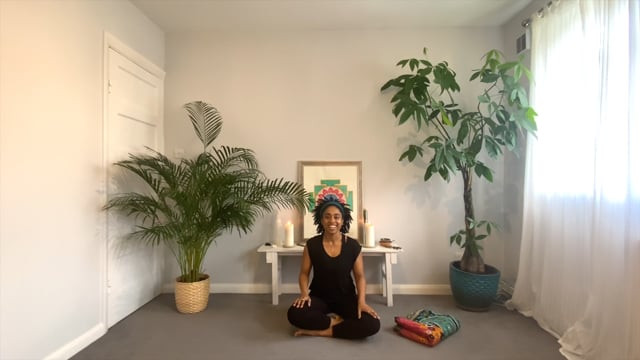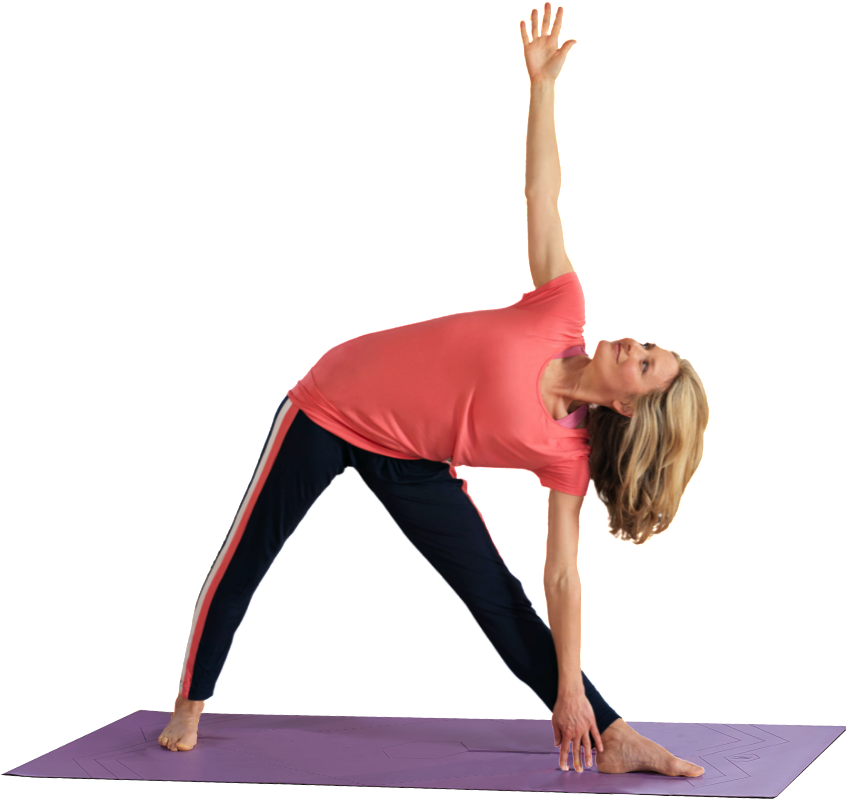For Teachers
Advice and discussions for teaching yoga. Use these videos to find out more about the philosophy behind yoga or when you need advice, inspiration and motivation to take your teaching to the next level.
-
 29:11
29:11Blissful Awareness
An open level meditation practise to balance the soothing and intense energies within you. Using this mediation, we invite you to rest in the peaceful ground of being, getting under all the layers of your personality and lived experience to discover your blissful stillness. This space is the ground of your consciousness and your true identity. You may wish to sit on a cushion or in a chair with a blanket for support during this practice.
-
 01:03:33
01:03:33Full Body Tone
An open level movement class to tone the full body, circulate the breath and energy body while connecting you to a meditative awareness. This class is playful and energetic offering poses such as crow and wheel, with variations for all abilities. You may need a block.
-
 21:59
21:59Flying Splits Flow
This yoga tutorial shows how to transition from koundinyasana (flying splits) 1 and 2, exiting through a chaturanga vinyasa. Starting with a short vinyasa flow, this class is suitable for those with an intermediate practice, looking for some fun and strong variations. We recommend first watching the koundinyasana tutorial first. Expect a relevant conditioning introduction but being fully warmed up will always be helpful for moving into the more 'advanced' poses.
-
 01:10:41
01:10:41Yoga for Sore Feet & Ankles
Our feet are our foundations; we rely on our feet and ankles to carry us around all day. Quite a remarkable task if you stop to think of the proportions of two small feet carrying one tall person! In this yoga and anatomy tutorial video you will learn so much about your feet and ankles and develop a new found respect and gratitude for this remarkable part of our anatomy. Discover how to use your feet for optimum posture and easeful movement throughout your day, and on your yoga mat. Practice some movement to help you understand how you can strengthen and mobilise this area. Plus, learn about how to support common conditions relating to the feet including sprains, plantar fasciitis, Achilles tendon problems, bunions and hallux rigidus. Please note that all advice and recommendations in this film are given generally and do not constitute any form of an individual diagnosis or treatment plan. A consultation with a medical practitioner or registered physical therapist is recommended. Practice to help you understand how you can strengthen and mobilise the foot and ankle.
-
 37:53
37:53Yoga for Osteoporosis & Osteopenia
Osteoporosis is said to affect over 3 million people in the UK (NHS). This condition (and it’s younger sister osteopenia) affects the density of the bones and so their strength, resilience and support. In this video, Lucy & Ben explain in clear and simple terms what proactive measures can be taken to reduce the risks of developing these conditions. They explore how to work within certain parameters to help should you have a reduced bone density and finally offer a better understanding of opportunities to maintain the health of the bones. Remember, many people only learn of any weakness in their bones when they have suffered a fracture. As we age it’s vitally important that we protect the strength of our bones and respect the role they have in our health and mobility. Prevention really is key here, watch this video to find out how and why! Please note that all advice and recommendations in this film are given generally and do not constitute any form of an individual diagnosis or treatment plan. A consultation with a medical practitioner or registered physical therapist is recommended.
-
 42:05
42:05Anatomy of Breathing
You can hardly get through five minutes of any good yoga class without being reminded to breathe. Of course, all of us breathe every second of every day, we do it instinctively. However, how much do we all know about the mechanics of breathing and how we can optimise our breathing for our health and wellbeing? This yoga anatomy video offers an invaluable insight into the anatomy of your breath and how to use your breath on and off your yoga mat to help you feel good both physically as well as mentally. Please note that all advice and recommendations in this film are given generally and do not constitute any form of an individual diagnosis or treatment plan. A consultation with a medical practitioner or registered physical therapist is recommended.
-
 20:53
20:53Yoga For Scoliosis
Scoliosis is a curvature of the spine which can present in spectrum of different grades. For some, a scoliosis can be very mild, hardly noticeable and certainly not an issue for everyday movement and living. For others it can be very inhibiting, restricting movement, causing pain and discomfort, perhaps even leading to corrective surgery. In this video, Lucy & Ben explain what scoliosis is and explore how you can help yourself, or loved ones, with this condition. Explore the role of good breathing and gentle movement to stretch out and gain ease and comfort. Please note that all advice and recommendations in this film are given generally and do not constitute any form of an individual diagnosis or treatment plan. A consultation with a medical practitioner or registered physical therapist is recommended.
-
 18:47
18:47Journalling: The Magic in Everyday
Open yourself up to creativity and fun with journalling! This journalling class explores the magic of ordinary objects. We can see many examples in literature where ordinary objects are given great importance or power: a stick becomes Harry Potter's magic wand; a playing card becomes the symbol of an evil villain; a golden ring becomes something that can destroy the world! For this session, Ash asks you to collect five objects from your house or garden as inspiration for our journal journey. We highly recommend journalling as a practice, and this class brings your creativity and imagination to the process.
-
 41:34
41:34Yoga For Illness and Recovery
How can yoga support us through times of illness and recovery? We talk with Lizzie Reumont, a Jivamukti yoga teacher and Rolfer, who has experienced a number of illnesses through her life. We explore with Lizzie what happens physically and mentally when our body lets us down; how can we practice in a way which nourishes us and supports us; and how we can show up for ourselves as we go through difficult times. Why not check out our Gentle Yoga for Times of Illness course
-
 26:15
26:15How Yoga Can Help with Long Term Illness
How can yoga help to brighten our lives? Barbara is a yoga teacher who specialises in teaching cancer patients. This insightful talk investigates how yoga can help us to live each day with a true acceptance of our lives, exactly as they are right now. She discusses how learning from the philosophy of yoga is integral to recovery from and living with long-term illness. We also discuss how yoga can help us to keep us more mobile and free of pain, can increase our stimulate focus and lung capacity.
-
 55:35
55:35Buddha's Teachings: Yoga for Equanimity
This gently flowing yoga and Qi Gong class explores the fourth of the brahmavihārās, or boundless states, known as upekkha, or equanimity. This fourth abode is often the most misunderstood, as equanimity can easily be written off as indifference and not caring. The Buddha’s teachings suggest this is far from the truth. His description of upekkha is that it is a perfect, unshakable balance of heart and mind, rooted in insight. When we cultivate equanimity, we cultivate a state of being even minded and calm. In this state, we learn to trust, meet and respond to life in ways that let us care deeply and fully about what truly matters. We make room for joy, pain, sorrow and challenges. We learn to meet life in ways that neither opposes nor demands more from it, and can remain steady, trusting and open to whatever grim corners we may turn in life.
-
 05:45
05:45Chants to the Goddesses
If you need strength in your life, it's time to chant to the goddessses! Join in chants of wonderful aspects of the divine feminine. These invocations are to the Goddess’s Durga the warrior goddess, Lakshmyai the bestower of wealth and generosity and Saraswati. the Goddess of knowledge and music, poetry and dance. These chants are said to connect us to the divine feminine, Mother Earth and these qualities. The chants are: Om Shri Durgayai namah Om Shri Maha Lakshmyai namah Om aim Sarasvatayi namah. Open your mind and enjoy!
Join the Wellbeing Revolution
This is your yoga, your way.
Build a happier, healthier, more sustainable life.
